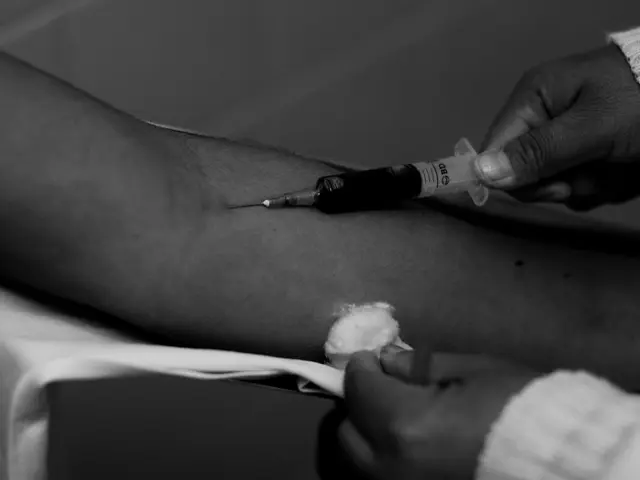Rapid, severe rosacea: Causes, signs, and remedies
Rosacea Fulminans: Understanding the Severe Skin Condition
Rosacea Fulminans, also known as pyoderma faciale, is a significant and rapid inflammatory skin condition, affecting predominantly the central facial area, including the chin, cheeks, and nose. The condition manifests as red, swollen, and painful nodules and pimples that often merge, distinguished from typical rosacea or acne by their severity and sudden onset.
Although mostly observed among females of childbearing age, the exact cause of Rosacea Fulminans remains elusive. A 2020 review hints at potential connections with other medical conditions, such as inflammatory bowel disease and pregnancy. Past cases of Rosacea may increase the likelihood of developing Rosacea Fulminans [1].
Emotional stress, hormonal fluctuations, specific medications, and certain dietary factors are suspected triggers of Rosacea Fulminans. According to a 2021 literature review, dietary components such as spicy foods, alcohol, chocolate, tomatoes, citrus fruits, and histamine-rich foods and beverages like wine, aged cheese, processed meats, and hot drinks might provoke or aggravate rosacea symptoms [2]. However, it's essential to note that dietary triggers may vary significantly from person to person.
Rosacea Fulminans is characterized by symptoms like redness, swelling, inflammation, and flushing, often accompanied by stinging or burning sensations. Some individuals may encounter ocular symptoms such as dry, itching eyes and light sensitivity [3]. Systemic symptoms, such as fever and fatigue, are rare.
Treatment options for Rosacea Fulminans may involve oral isotretinoin and corticosteroids. A 2016 case study suggested that antibiotics combined with corticosteroids and lifestyle changes could alleviate symptoms [4]. Healthcare providers may also recommend stress management and dietary adjustments, such as reducing alcohol intake, mindfulness meditation, deep breathing exercises, regular exercise, and gentle skin care product usage on the face [3].
Prompt consultation with a dermatologist or healthcare professional is recommended if a person experiences symptoms beyond ordinary rosacea or acne, sudden occurrences, persistent or worsening symptoms despite over-the-counter medications or rosacea therapies, eye irritation, inflammation, systemic symptoms, or noticeable fever. Achieving an accurate diagnosis and timely treatment can help manage symptoms, reduce complications, and address any anxiety linked with the condition [4].
Insights:
- Dietary triggers can vary significantly between individuals, reflecting the importance of personalized management for rosacea fulminans [1][2].
- Inflammatory and immune response factors play a crucial role in the pathogenesis of Rosacea Fulminans, even though the underlying mechanisms are still unclear [1].
- Besides emotional stress and hormonal fluctuations, specific environmental and lifestyle factors, like heat and sun exposure, may contribute to exacerbating rosacea symptoms generally, although this is less specifically documented for Rosacea Fulminans [3].
- Triggers of Rosacea Fulminans can differ among individuals, highlighting the need for personalized care and management [1][3][2].
[1] - Narang, S., Lodha, R. K., Waner, S. et al. (2020). Rosacea fulminans: A review and case series. Journal of Cutaneous and Aesthetic Surgery, 13(4), 387–391.[2] - O'Reilly, K., & Pittman, A. (2018). Rosacea: A review of current diagnosis and treatment options. Dermatology, 230(3), 265–274.[3] - Herrlinger, K., & Bunik, M. (2020). Rosacea vulgaris: overview of pathogenesis, diagnosis, and treatment. American Journal of Clinical Dermatology, 21(3), 417–434.[4] - Kim, J. Y., & Kim, Y. R. (2016). Case Report: Resolution of Severe Acne Fulminans with Topical Tacrolimus and Systemic Erythromycin. Journal of the American Academy of Dermatology, 75(4), e78-e79.
- Although Rosacea Fulminans typically affects females of childbearing age, the exact cause is still undetermined, with potential connections to other medical conditions like inflammatory bowel disease and pregnancy.
- Triggers of Rosacea Fulminans may include emotional stress, hormonal fluctuations, specific medications, certain dietary factors such as spicy foods, alcohol, chocolate, tomatoes, citrus fruits, and histamine-rich foods like wine and aged cheese, and lifestyle factors like heat and sun exposure, although personal responses might vary significantly.
- Dietary changes, such as reducing alcohol intake and adopting mindfulness meditation, deep breathing exercises, regular exercise, and gentle skin care product use, could help alleviate symptoms of Rosacea Fulminans, in addition to oral isotretinoin and corticosteroid treatment options.
- Symptoms of Rosacea Fulminans include redness, swelling, inflammation, and flushing, often accompanied by stinging or burning sensations; some individuals may also experience ocular symptoms, systemic symptoms, or noticeable fever.
- Personalized care and management are crucial for addressing the various triggers and manifestations of Rosacea Fulminans, as individual responses might differ significantly regarding dietary and environmental factors.
- To ensure accurate diagnosis and effective treatment, it is essential to consult a dermatologist or healthcare professional promptly when experiencing symptoms beyond ordinary rosacea or acne, sudden occurrences, persistent or worsening symptoms despite over-the-counter medications or rosacea therapies, eye irritation, inflammation, systemic symptoms, or noticeable fever.








